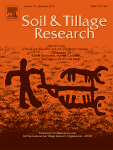Ver ítem
- xmlui.general.dspace_homeCentros Regionales y EEAsCentro Regional Entre RíosEEA ParanáArtículos científicosxmlui.ArtifactBrowser.ItemViewer.trail
- Inicio
- Centros Regionales y EEAs
- Centro Regional Entre Ríos
- EEA Paraná
- Artículos científicos
- Ver ítem
Platy structure development under no-tillage in the northern humid Pampas of Argentina and its impact on runoff
Resumen
The no-tillage system (NT) is widespread in the silty soils of the Argentine Humid Pampas. The aims of this study were i) to characterize the evolution of the structure of the A horizon in the northern Humid Pampas due to conversion to NT, particularly the presence of platy structure and its development through time, by taking advantage of a chronosequence since conversion to NT; and ii) to evaluate how platy structure extension in the A horizon relates
[ver mas...]
The no-tillage system (NT) is widespread in the silty soils of the Argentine Humid Pampas. The aims of this study were i) to characterize the evolution of the structure of the A horizon in the northern Humid Pampas due to conversion to NT, particularly the presence of platy structure and its development through time, by taking advantage of a chronosequence since conversion to NT; and ii) to evaluate how platy structure extension in the A horizon relates to characteristics of the crop sequences and runoff in a long-term experiment. Thus, the structure of the A horizon of 25 Argiudolls with different NT history was analyzed using a visual structure evaluation (VSE) method (“le profil cultural”). Fourteen natural-rainfall erosion plots with 3.5% slope were used to analyze the relationship between the soil structural state, the crop sequence and runoff. The VSE method allowed us to understand the structure type organization of silty soils under NT, highlight the regional extent of a platy structure near the soil surface, and study its evolution and impact on runoff. All the sites analyzed exhibited a horizontal platy structure (2–10 cm thick), mainly developing on the soil surface or right under the granular structure on the soil surface. Under the platy structure, a cΦ structure was observed in all the sites (30–75% of the A horizon). A relationship was found between the number of consecutive years under NT and the proportion of platy structure. This evolution may result from the combination of an initial development of the platy structure and a late development of a cГ structure from the soil surface. The results obtained during the five-year period analyzed allowed us to prove that platy structure alters the drainage pattern, restricts water entry into the soil and favors surface runoff according to its proportion in the profile of A horizon.
[Cerrar]

Autor
Sasal, Maria Carolina;
Boizard, Hubert;
Andriulo, Adrian Enrique;
Wilson, Marcelo German;
Léonard, Joel;
Fuente
Soil and tillage research 173 : 33-41. (November 2017)
Fecha
2017
ISSN
0167-1987 (Print)
1879-3444 (Online)
1879-3444 (Online)
Formato
pdf
Tipo de documento
article
Palabras Claves
Derechos de acceso
Restringido
 Excepto donde se diga explicitamente, este item se publica bajo la siguiente descripción: Creative Commons Attribution-NonCommercial-ShareAlike 2.5 Unported (CC BY-NC-SA 2.5)
Excepto donde se diga explicitamente, este item se publica bajo la siguiente descripción: Creative Commons Attribution-NonCommercial-ShareAlike 2.5 Unported (CC BY-NC-SA 2.5)

